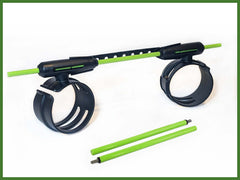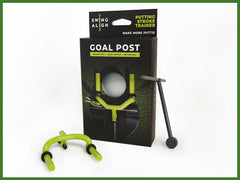The Inside Out Golf Swing
Most golfers know that an inside out golf swing is better. Swinging on a more inside to out path on the way down creates more speed, solid contact and a square face by using your body to control and power your swing. It allows you to square the clubface more consistently to hit a straighter shot or even a draw. But perhaps the most important benefit is eliminating the over the top golf swing that produces poor contact and shots that slice. Those weak shots cause frustration for a lot of golfers. But don’t despair... there's hope and several easy fixes to stop coming over the top and develop an inside out golf swing!
In this article we will go over the ways to stop coming over the top and produce a better golf swing path. The three areas we will cover are…
Over The Top Golf Swing
An over the top golf swing produces an outside-in downswing which is usually accompanied by an open clubface resulting in a slice. For a RH golfer this means a shot that typically starts to the left of the target and curves too much to the right. For most golfers it feels natural to try to power the downswing with your arms and shoulders, however this causes the club to move out, around and then across your body on the way down. This is the classic over the top swing that millions of golfers battle.
With a little work and some simple drills, you can stop coming over the top and it starts with your set up and backswing. First, make sure your shoulders are square to your target line. This sounds easy but most golfers ignore working on their setup in favor of hitting balls. Setting up square to your target line is the first step to a good takeaway and turn which allows you to make a inside out golf swing. All golfers can set up square every time regardless of skill level.
How To Stop “Coming Over The Top” Golf Swing
On the takeaway focus on moving the clubhead with your lead shoulder and chest. Check that your clubhead remains just outside your hands on the way back - you can do this by stopping the club when it is parallel to the ground. The goal is to not let your arms or hands whip the clubhead to the inside.
Be sure to fully rotate your chest and hips to complete your backswing. If you do, you'll be in a great position at the top with enough room to let your arms drop the club to the inside and let your body rotate the club to impact. Remember good backswing mechanics help you eliminate most downswing flaws.
Stopping your shoulders from taking over in the downswing is the key move to stop coming over the top. Try the bump to shallow drill shown below. You don’t even need a club.
- Rotate like you are making a backswing and place your hands on a wall as shown in the pictures below
- While keeping your hands on the wall, practice the feeling of your lower body and lead hip making a little forward bump and rotation towards the target.
- Your lead shoulder will start to move up and your trail arm will drop below your lead arm. Don't let your lead shoulder take over and dive down to the ball first.


When you learn to move your lower body first on the downswing, your arms will drop and your lower body will lead you back to the ball with an inside to out golf swing path! When you make an over the top golf swing the opposite happens. Your lead shoulder moves out and down and your trail arm follows, going “over the top”.
Golf Swing Path
The golf swing path refers to the angle at which the clubhead moves away from and then back to the golf ball. On the downswing, it is more desirable to return the club from an inside to square path angle. An inside path angle with a square clubface will produce really solid contact and stop you from slicing. A twofold benefit!
A great way to think about your swing path is in two stages. As you rotate back with your chest and hips, keep the clubhead just outside your hands. On the downswing feel like the clubhead is slightly behind your hands coming from the inside.
Try this slow half swing drill to ingrain the feeling of the proper golf swing path. Slow purposeful swing movements have been proven to be more effective than trying to feel swing changes at full speed.
- Rotate the club back to waist high and stop. Remember to turn like you are making a mini golf swing. The clubhead should be outside your hands. (Pro Tip: the clubface should point back towards the ball - don't let your wrists roll open).
- Next, without moving your shoulders, rotate your lower body towards the target and move the clubhead just inside your hands keeping the toe of the club angled.
- From there, rotate to get the club to impact feeling the club come from the inside and behind your hands. Check your impact position to make sure you are squaring the clubface.

Work on half swings at slow speed then transition three quarter swings, then move to full speed, full swings on the range, mimic the feel you get from the two waist high positions show above - on the backswing and downswing. Feel the club passing through those two positions on a full swing.
Inside Out Golf Swing
There are many benefits of an inside out golf swing.
- More power
- Solid contact
- More distance
- Straighter shots / less slices
- Better trajectory control
- Feeling good about your swing!
As described earlier the keys are a square set up, using your body, chest and hips to take the club away, keeping the clubhead just outside the hands. Don't roll your wrists or whip the clubhead inside. Backswing mechanics are important and usually the root cause for most of golf’s problems. So put some time in working on your alignment and takeaway.
On the downswing, move your lower body back to the golf ball first. Allow your lead hip to bump forward and rotate, and let your arms to drop before rotating your shoulders. This will move the club to the inside of your hands for an inside to out golf swing. Your shoulders are big dominant muscles used in lots of athletic movement. But if they move first on a golf downswing your arms will go out and over the top and you’ll struggle to feel and then ingrain an inside out golf swing.
Driver Swing Path
The driver is one of, if not the most important club in your bag. It sets you up for success by hitting a shorter club into the green, but also inflicts maximum pain if you hit a weak slice. Oftentimes how you feel about your golf swing, or your attitude during a round of golf is entirely dictated by your driver performance.
Your driver swing path is therefore critical.
As discussed prior, setting up square to your target is essential, even more so with your driver. Too often golfers set up with their shoulders open on the tee and the ball tends to go where the shoulders are pointed (not your feet). If you start with your shoulders open you’ll automatically pull the clubhead inside and then come back out over the top. Put another way, the more open your shoulders are at address, the more you have to rotate to get them to a good position at the top.
Good tempo is critical to creating the correct driver swing path. Make an effort to swing the driver back slowly keeping the clubhead just outside your hands. Because the driver is the longest club in your bag, don’t rush, or your timing will get out of whack early and you’ll never recover.
At the top of your driver swing, keep that smooth tempo as you transition to your downswing. The all too common urge at the top of your driver swing is to kill the ball. Don’t give in or your shoulders will take over. Instead, feel your lower body move first while holding back your shoulders. Let your trail arm drop down so that you can unwind and bring the club back to the ball from the inside with maximum power. Once you get this feeling you will start hammering your drives.
Since you get to put the ball on a tee with your driver, a simple visual reminder to drop the club and swing from the inside on the way down is to orient the logo on your golf ball pointing from the inside to out to reinforce the ideal driver swing path.
Golf Swing Path Trainer
Consider a swing trainer like Swing Align to assist you in your quest for a better golf swing path. Swing Align has strong visual references to help guide your swing movements.
Spend some time working on your alignment! The benefits are huge and it's easy when you have Swing Align's visual reference to automatically get your shoulders square. A good setup is the key to good movement, including your golf swing path.
An inside out golf swing is only possible when you fully rotate your chest on the backswing giving yourself enough room for your arms to drop into “the slot”. When good golfers talk about having their swing in the slot they are referring to returning the club to the ball with an inside out swing. When that feeling is effortless nothing is better as you stripe solid shot after solid shot. This is the feeling in golf everyone chases.
Dropping into the slot from the top is not natural to most golfers. The wearable alignment rod on Swing Align can help you visualize full rotation and the feeling of holding your shoulders back while your lower body starts the downswing. It helps you visualize your arms dropping versus coming out and over the top. Without rotating your shoulders point the angle of the rod up at the start of your downswing. Drop the club and drop your trail arm under your lead arm and your path coming from the inside.

Swinging on an inside to out path allows you to create more power, more speed, solid contact and longer straighter golf shots. Put your game on the right path with an inside out swing, with Swing Align as your guide.
















